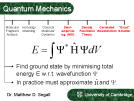


| home |
| News [NEW] |
| Career Week |
| schedule |
| syllabus |
| instrumentation lab |
| homework |
| handouts |
| Research |
| textbooks |
| Tutor |
| part-time options |
| credit distribution |
| faculty contact |
| pre-requisites |
Atoms, Molecules and Research (AMR) 2003/04
A Learning Community in Upper Division Chemistry
| Quantum Mechanics Homework - Spring quarter |  |
Week |
Chapter |
Problems |
Due Date | Answer Keys |
| 9 | 13 | 17, 51, 52 Continue working on HBr |
Tuesday, Week 10 | |
| 8 | 13 | 44, 45, 47 Continue working on HBr |
Tuesday, Week 9 | Answer Key |
| 7 | 13 | 1, 2, 3, 5, 8, 9, 10, 11, 12 | Tuesday, Week 8 | Answer Key |
| 6 | re-do mid-term exam | Tuesday, Week 7 | Answer Key | |
| 5 | 11 | 17, 25, 27, 28, 29 | Tuesday Week 6 | Answer Key |
| 4 | 11 | 7, 9, 11, 12 | Tuesday, Week 5 | Answer Key |
| 3 | 11 | See this sheet | Tuesday, Week 4 | Answer Key |
| 2 | 11 | See this sheet | Tuesday, Week 3 | Answer Key |
| 1 | 11 | 1, 2 | Tuesday, Week 2 | Answer Key |
Important Concepts to Study:
| Week |
Concepts |
| 8 | Understand the equations for the rotational spectra of diatomic molecules using the non-rigid rotor model, the effect of isotopic substitutions, population in rotational levels, principal axes of rotation for non-linear polyatomics and the corresponding moments of inertia, Classification of non-linear polyatomics into various tops based on moments of inertia |
| 7 | Understand Boltzmann distribution, degeneracy of rotational levels, application of the rigid rotor model to understand rotational spectra of diatomic molecules. |
| 5 | Huckel molecular orbital theory as it applies to planar, conjugate, polyenes |
| 4 | determine the ground state term symbol for any simple, heteronuclear diatomic molecule or molecular ion, write wavefunctions for hybrid orbitals |
| 3 | Complete wavefunction and the Hamiltonian for diatomic molecules, determine the ground state term symbol for any homonuclear diatomic molecule or molecular ion. |
| 2 | Write the complete wavefunction for H2+(this means be able to do this week's homework on your own), understand the connection between the mathematical and graphical representations of the wavefunction for diatomic molecules, definitions of Coulomb integral, resonance integral and overlap integral |
| 1 | Write the complete Hamiltonian for any diatomic molecule and identify the individual terms, understand the Born-Oppenheimer approximation and its implications, draw the potential energy curves for H2 and H2+, recognize that the potential energy curve is a sum of two curves, be able to re-produce the potential energy curve for H2+ with the detailed information we learned in class. |